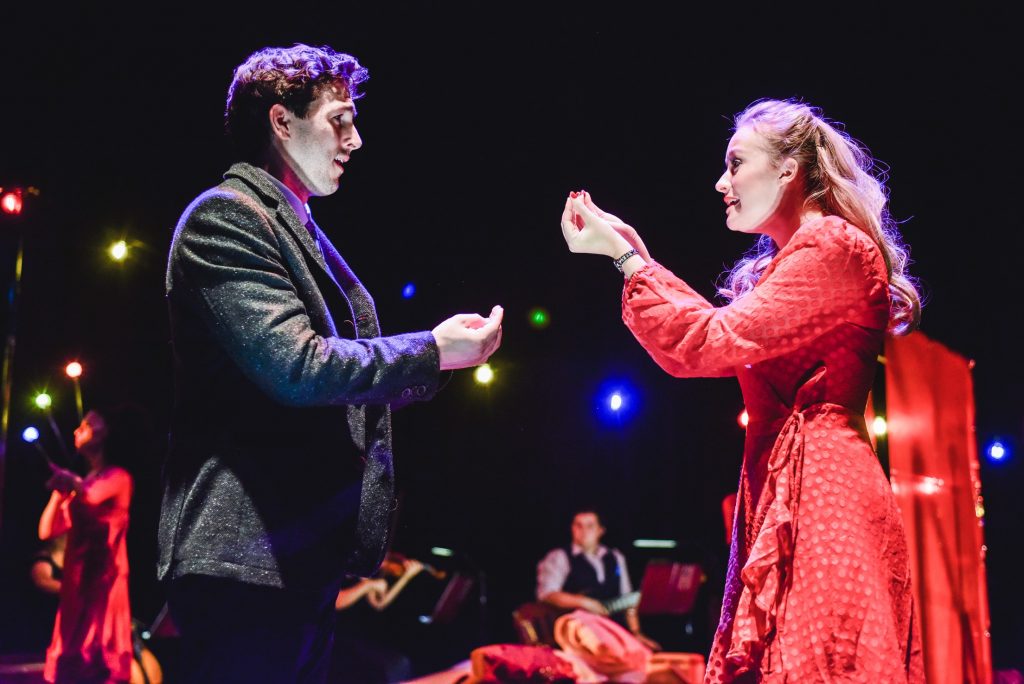Leeway Theatre’s production of Jason Robert Brown’s The Last Five Years, brought here to the stage by director Angharad Lee and choreographer Mark Smith as part of the Performances for the Curious, has an interesting take on what could in some ways be deemed a fairly simple tale. The approach is certainly ambitious, and experimental in more than one way; in some aspects the production achieves its goals, but in others it falls somewhat short of the mark. The musical, which has plenty of moving, recognisable, and catchy tunes to its name, tells – in a somewhat non-linear fashion – the love story between ambitious wannabe writer Jamie and struggling actress Cathy, a love story that we know from the very first scene to be a doomed one; the two characters experiment the plot in opposite directions, with Cathy telling it from the end to the beginning, and Jamie from the beginning to the end. The narrative trick is well exploited here, strikingly marking the fact that we never see Jamie and Cathy really interact directly with each other, except in a single scene exactly midway through. This provides powerful and effective commentary on the lack of communication that lies at the bottom of the failure of their relationship.
Michael Hamway and Lauren Hood
The fact that the two characters are never truly witnessed directly in their interactions also means that the audience never gets to have an objective narrative of what is truly happening. The musical becomes then, really, a game of unreliable narrators, and both the direction and the actors are clever here in dropping subtle hints to highlight this fact. It is easy at the beginning to be entirely sympathetic with Cathy, but as the story develops and the audience gets a closer look at Jamie’s take on it, perspectives become muddled, and it is hard in the end to be entirely certain of what truly happened, on who lied and when, and who overly magnified what detail in their head. For a musical that is clearly first and foremost a double psychological study, putting emphasis on this aspect of the narration serves to enhance its exploration of its characters.
Perhaps the most striking feature of this production, however, is the clever way in which BSL is integrated in the performance. There has recently been in Welsh theatre a most welcome attention to accessibility and the discourse surrounding the artistic exploration of it (with close captions, for instance), and this is perhaps one of the most inventive takes on the topic so far. It also taps into the psychological discourse in an almost seamless way: each of the two characters is provided with an (almost) silent double, which is the same character but which also appears to directly interact with them, almost a projection of their subconscious – or perhaps a projection of the idealised version of each other that the two characters perceive. The integration of BSL in the choreography is fluid, interesting, and provides thoughtful commentary on the theme of communication or lack thereof, through perhaps it would have been more effective if the demarcation between the two versions of each character had been more clear-cut: it is sometimes a bit jarring to see the ‘talking’ character signing as well, and this can detract from the impact of the duplication itself.
This is the main problem this production has, and it applies to a variety of other aspects as well: it comes up with very good ideas, but often cannot focus on them, or only carries them halfway through. The gimmick of showing the progression of the love story in the two timelines through dates on cardboard boxes is clever and effective, but gets pretty much abandoned halfway through, and only recovered in a rush towards the end. The alternate characters are silent, except in one or two random occasions in which they speak, for no particular reasons. There is an effective, smart opposition between the singing and the danced signing, except when the singers are signing too. This can create a frustrating sense of incompleteness and confusion, heightened by a stage setting that is far too overcrowded and heavy, limiting the actors in their performance and making the narrative harder to follow.
Supported by strong performances by all four members of cast (Anthony Snowden and Michael Hamway as Jamie, Lauren Hood and Raffie Julien as Cathy), The Last Five Years has many good and unconventional ideas, creates many intriguing and impactful reflections, but would greatly benefit from being more polished, more committed to its narrative techniques, and set on a less cluttered stage. The final impression is that of a project with great potential, not fully realised – a starting point more than an arrival line, intelligent and worthy of consideration but with an unrealised ability to explore its ideas much further.
Images: Kirsten McTernan
Main image: Raffie Julien and Anthony Snowden
Until November 17
What makes Arts Scene in Wales unique:
